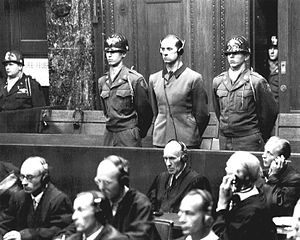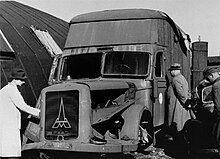
The Schutzstaffel was a major paramilitary organisation under Adolf Hitler and the Nazi Party in Nazi Germany, and later throughout German-occupied Europe during World War II.

Karl Brandt was a German physician and Schutzstaffel (SS) officer in Nazi Germany. Trained in surgery, Brandt joined the Nazi Party in 1932 and became Adolf Hitler's escort doctor in August 1934. A member of Hitler's inner circle at the Berghof, he was selected by Philipp Bouhler, the head of Hitler's Chancellery, to administer the Aktion T4 euthanasia program. Brandt was later appointed the Reich Commissioner of Health and Emergency Services. Accused of involvement in human experimentation and other war crimes, Brandt was indicted in late 1946 and faced trial before a U.S. military tribunal along with 22 others in the Doctors' Trial. He was convicted, sentenced to death, and hanged on 2 June 1948.
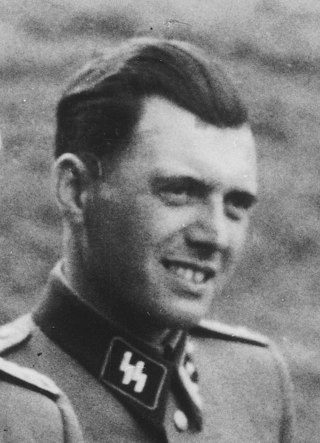
Josef Rudolf Mengele was a German Schutzstaffel (SS) officer and physician during World War II at the Russian front and then at Auschwitz during the Holocaust, where he was nicknamed the "Angel of Death". He performed deadly experiments on prisoners at the Auschwitz II (Birkenau) concentration camp, where he was a member of the team of doctors who selected victims to be murdered in the gas chambers, and was one of the doctors who administered the gas.

Aktion T4 was a campaign of mass murder by involuntary euthanasia which targeted people with disabilities in Nazi Germany. The term was first used in post-war trials against doctors who had been involved in the killings. The name T4 is an abbreviation of Tiergartenstraße 4, a street address of the Chancellery department set up in early 1940, in the Berlin borough of Tiergarten, which recruited and paid personnel associated with Aktion T4. Certain German physicians were authorised to select patients "deemed incurably sick, after most critical medical examination" and then administer to them a "mercy death". In October 1939, Adolf Hitler signed a "euthanasia note", backdated to 1 September 1939, which authorised his physician Karl Brandt and Reichsleiter Philipp Bouhler to begin the killing.
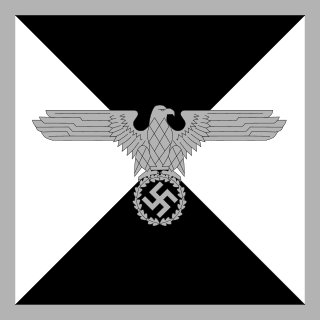
Reichsführer-SS was a special title and rank that existed between the years of 1925 and 1945 for the commander of the Schutzstaffel (SS). Reichsführer-SS was a title from 1925 to 1933, and from 1934 to 1945 it was the highest rank of the SS. The longest-serving and most noteworthy office holder was Heinrich Himmler.
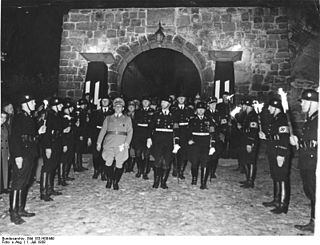
The Allgemeine SS was a major branch of the Schutzstaffel (SS) paramilitary forces of Nazi Germany; it was managed by the SS Main Office (SS-Hauptamt). The Allgemeine SS was officially established in the autumn of 1934 to distinguish its members from the SS-Verfügungstruppe, which later became the Waffen-SS, and the SS-Totenkopfverbände, which were in charge of the Nazi concentration camps and extermination camps. SS formations committed many war crimes against civilians and allied servicemen.
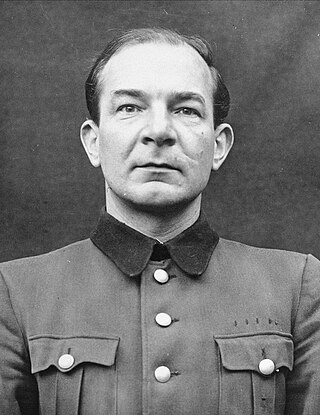
Joachim Mrugowsky was a Nazi bacteriologist who committed medical atrocities at the Sachsenhausen concentration camp. He was Associate Professor, Medical Doctorate, Chief of Hygiene Institute of the Waffen-SS, Senior Hygienist at the Reich, SS-Physician, SS and Waffen-SS Colonel. He was found guilty of war crimes following the war in the Doctors' Trial and executed in 1948.
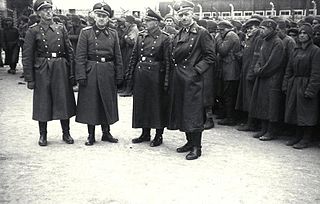
SS-Totenkopfverbände was a major branch of the Nazi Party's paramilitary Schutzstaffel (SS) organisation. It was responsible for administering the Nazi concentration camps and extermination camps for Nazi Germany, among similar duties. It was both the successor and expanded organisation to the SS-Wachverbände formed in 1933. While the Totenkopf was the universal cap badge of the SS, the SS-TV also wore this insignia on the right collar tab to distinguish itself from other SS formations.

Karl Franz Gebhardt was a Nazi physician and a war criminal. Gebhardt was the main coordinator of a series of medical atrocities performed on inmates of the concentration camps at Ravensbrück and Auschwitz. These experiments were an attempt to defend his approach to the surgical management of grossly contaminated traumatic wounds, against the then-new innovations of antibiotic treatment of injuries acquired on the battlefield.

Ernst-Robert Grawitz was a German physician and an SS functionary during the Nazi era. Grawitz funded Nazi programs involving experimentation on inmates in Nazi concentration camps and was part of the group in charge of the murder of mentally ill and physically disabled people in the Action T4 programme. In April 1945 as the Soviet Red Army advanced on Berlin, Grawitz killed himself and his family.

Waldemar Hoven was a Nazi physician at Buchenwald concentration camp, and convicted war criminal for conducting human experiments regarding typhus which led to the deaths of many concentration camp prisoners, and as one of the organizers of the euthanasia program Aktion T4; this Nazi initiative resulted in the systematic murder of 275,000 to 300,000 disabled people. He was sentenced to death and hanged on 2 June 1948.
The SS Main Office was the central command office of the Schutzstaffel (SS) in Nazi Germany until 1940.
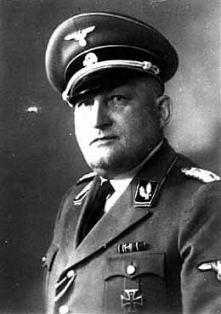
Richard Glücks was a high-ranking German SS functionary during the Nazi era. From November 1939 until the end of World War II, he commanded the Concentration Camps Inspectorate, later integrated into the SS Main Economic and Administrative Office as "Amt D". As a direct subordinate of Heinrich Himmler, he was responsible for the forced labour of the camp inmates and was the supervisor for the medical practices in the camps, ranging from Nazi human experimentation to the implementation of the "Final Solution", in particular the mass murder of inmates with Zyklon B gas. After Germany capitulated, Glücks committed suicide by swallowing a potassium cyanide capsule.
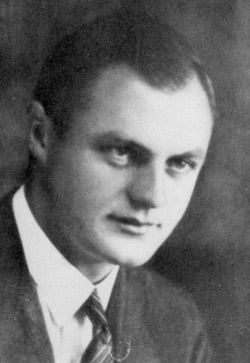
Eduard Wirths was the chief SS doctor at the Auschwitz concentration camp from September 1942 to January 1945. Thus, Wirths had formal responsibility for everything undertaken by the nearly twenty SS doctors who worked in the medical sections of Auschwitz between 1942 and 1945.

Nazi human experimentation was a series of medical experiments on prisoners by Nazi Germany in its concentration camps mainly between 1942 and 1945. There were 15,754 documented victims, of various nationalities and age groups, although the true number is believed to be more extensive. Many survived, with a quarter of documented victims being killed. Survivors generally experienced severe permanent injuries.
Units and commands of the Schutzstaffel were organizational titles used by the SS to describe the many groups, forces, and formations that existed within the SS from its inception in 1923 to the eventual fall of Nazi Germany in 1945.

The Concentration Camps Inspectorate (CCI) or in German, IKL was the central SS administrative and managerial authority for the concentration camps of the Third Reich. Created by Theodor Eicke, it was originally known as the "General Inspection of the Enhanced SS-Totenkopfstandarten", after Eicke's position in the SS. It was later integrated into the SS Main Economic and Administrative Office as "Amt D".
The Sanitätswesen was one of the five divisions of a Nazi concentration or extermination camp organization during the Holocaust. The other divisions were the command center, the administration department, the Politische Abteilung and the protective detention camp.
Christian Heinrich Emil Hermann Voss was a German anatomist. Well known as a medical academic and textbook author he was also notorious for his experiments during the Third Reich.
